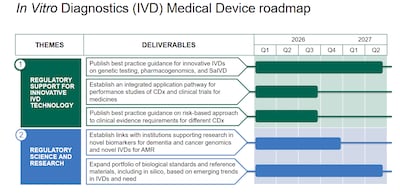ADVERTISEMENT
Regulatory
Roadmap version 1.0 is a living document, not a legislative instrument, that will be updated and tweaked for timings as necessary.
The European Medicines Agency scheduled oral explanation meetings for Sanofi’s MS drug and two other products nearing the end of their EU regulatory review cycle. These meetings typically give companies a final chance to convince the agency their drugs merit approval.
Seven new products, including Anavex’s Alzheimer’s candidate and GSK’s add-on asthma therapy, are up for an opinion from the European Medicines Agency on whether they should be authorized for use in the EU.
A submission to the FDA in the coming months for essential tremor drug ulixacaltamide could be swiftly followed by a filing of relutrigine for two rare forms of epilepsy.
New UK Cost-Effectiveness Thresholds Will Not Mean A Reprieve For Drugs Already Denied Reimbursement
Some companies in the UK undergoing a health technology appraisal by the HTA body, NICE, will see reimbursement recommendations for their products paused in the run up to the implementation of higher cost-effectiveness thresholds.
The MHRA’s premarket statutory instrument for Great Britain should to be laid before UK parliament in Q2 and be in force by year end, in an ideal world. There are concerns that the new statutory instrument must align with imminent EU MDR changes.
The company will exclude data from patients at the “small number” of sites that experienced irregularities and enroll new patients in their place.
CRN’s attorneys ask Second Circuit for en banc review of a three-judge panel’s denial of its appeal of 2024 decision in district court rejecting motion for preliminary injunction against enforcement of New York state law age-restricting sales of weight loss and muscle building supplements.
Pazdur’s departure just weeks into the job creates more uncertainty for the biopharma industry and an embarrassing situation for Commissioner Martin Makary, who personally lobbied him to take the position.
International reliance mechanisms for approving drugs have an important place, but the UK regulator should increase focus on becoming a first approver of medicines, according to the British pharmaceutical industry.
With the help of a purchased priority review voucher, the drug looks likely to become the first aldosterone synthase inhibitor to receive regulatory authorization, ahead of Mineralys' lorundrostat.
Under the newly-announced UK-US trade deal, the UK will increase the thresholds used to evaluate the cost-effectiveness of new medicines, which should allow higher prices for innovative therapies.











